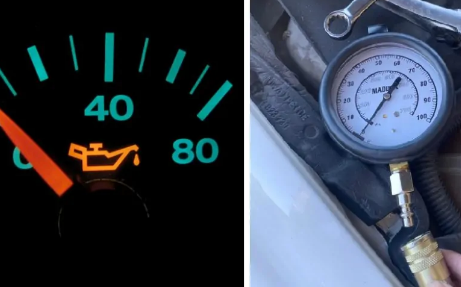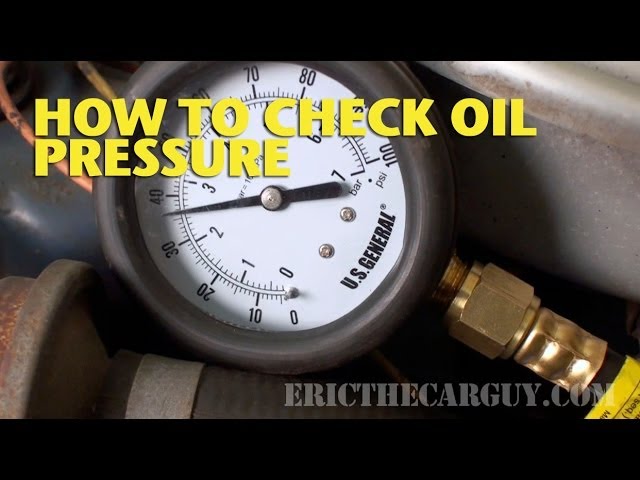To check oil pressure without a gauge, use a dipstick and inspect the oil level. Additionally, monitor the engine for any unusual noises or warning lights, which could indicate low oil pressure.
Checking the oil pressure is essential to ensure proper lubrication and prevent engine damage. Without a gauge, rely on visual cues and signs of potential issues to keep your engine running smoothly.
Credit: www.amazon.com
Why Is Oil Pressure Important For Your Vehicle?
Why is Oil Pressure Important for Your Vehicle?
Understanding the significance of oil pressure:
- Oil pressure is the force that ensures proper lubrication of the engine components, preventing friction and wear.
- It helps in maintaining optimal operating temperature by carrying away heat from engine parts.
- Oil pressure also ensures the efficient and timely delivery of oil to various engine components, keeping them well-lubricated to prevent damage.
- Adequate oil pressure is necessary for proper functioning of the engine’s timing chain or belt.
- Without appropriate oil pressure, the engine may experience reduced performance, increased fuel consumption, and eventually severe damage.
- Regularly monitoring oil pressure can help identify potential issues and address them before they lead to costly repairs.
It is crucial to know how to check oil pressure without a gauge to ensure the health and performance of your vehicle.

Signs Of Low Oil Pressure
Low oil pressure can cause serious damage to your vehicle’s engine if not detected and addressed in a timely manner. Identifying the symptoms of low oil pressure is crucial to prevent potential engine failure. One of the signs of low oil pressure is a dashboard warning light that illuminates, indicating a problem with the oil pressure level.
Additionally, you might notice unusual engine noise such as ticking or knocking sounds, which could be an indication of insufficient lubrication. Another symptom to look out for is an increase in engine temperature, as low oil pressure can result in poor cooling.
It is important to do regular visual inspections of your vehicle’s oil level and quality, as a sudden drop in oil level could signal low oil pressure. By being aware of these signs and promptly addressing any issues, you can ensure the longevity and performance of your vehicle’s engine.
Quick And Easy Methods To Check Oil Pressure Without Gauge
html
Method 1: Visual Inspection
Step 1: Park the vehicle on a level surface.
Step 2: Locate the oil filter and oil pan.
Step 3: Inspect for oil leaks.
Step 4: Check for oil pressure warning light.
Method 2: Manual Pressure Testing
Step 1: Acquire a mechanical oil pressure tester.
Step 2: Prepare the vehicle for testing.
Step 3: Connect the pressure gauge.
Step 4: Run the engine and observe pressure readings.
Method 3: Using Oil Pressure Test Kit
Step 1: Gather necessary tools.
Step 2: Locate the oil pressure sending unit.
Step 3: Remove the oil pressure sending unit.
Step 4: Connect the oil pressure gauge.
Step 5: Start the engine and read the pressure.
Precautions And Tips For Accurate Oil Pressure Measurement
Precautions and Tips for Accurate Oil Pressure Measurement:
It is crucial to ensure safety during oil pressure checks to prevent accidents or damage to the engine. Firstly, make sure to park the vehicle on a level surface and turn off the engine as checking oil pressure with a running engine can be dangerous.
Secondly, allow the engine to cool down to avoid any burns. Additionally, find the proper location to attach the pressure gauge by referring to the vehicle’s manual or consulting a professional. Clean the area around the oil pressure sending unit thoroughly before connecting the gauge to obtain accurate readings.
Moreover, check for air leaks or loose connections that could affect the oil pressure measurements. Lastly, it is important to avoid common mistakes like over tightening the connections, misinterpreting the gauge reading, or forcing a damaged gauge onto the engine.
By following these precautions and tips, you can obtain accurate oil pressure measurements and ensure the health of your engine.
Factors that can affect oil pressure readings:
When performing an oil pressure check, it is necessary to consider factors that may impact the readings. First, the type and viscosity of the oil used are essential, as thinner oils tend to have slightly lower pressure readings compared to thicker oils.
Additionally, worn-out or damaged oil pressure sensors can provide incorrect readings and need to be replaced. Also, an engine that is not properly warm can display lower oil pressure. Another crucial factor is the engine’s RPM (revolutions per minute), as oil pressure is directly proportional to engine speed.
Therefore, idle and high RPM readings may vary significantly. Lastly, it is important to note that different vehicle models may have different ideal oil pressure ranges. By being aware of these factors, you can interpret oil pressure readings more accurately and make informed decisions about your engine’s health.
Common mistakes to avoid during oil pressure checks:
During oil pressure checks, it is crucial to avoid common mistakes that can lead to inaccurate readings. Firstly, rushing the process can be detrimental as it may not allow the engine to cool down, leading to false readings.
Secondly, incorrect placement or improper seating of the pressure gauge can result in unreliable readings. It is important to follow the manufacturer’s recommendations for gauge attachment to ensure accuracy.
Moreover, misinterpreting the readings can be a common mistake, as pressure gauges may have different scales or units of measurement. Always refer to the vehicle’s manual for the correct oil pressure range and interpret the readings accordingly.
Lastly, over-tightening the connections can damage the gauge or the engine, while loose connections can cause leaks and inaccurate readings. By being cautious and avoiding these common mistakes, you can obtain more reliable oil pressure measurements and ensure the proper functioning of your engine.
Frequently Asked Questions For How To Check Oil Pressure Without Gauge
How Can I Check Oil Pressure Without A Gauge?
To check oil pressure without a gauge, start by checking for any warning lights on your vehicle’s dashboard. You can also listen for any unusual noises coming from the engine. Another simple method is to check the oil level and condition regularly.
If you suspect low oil pressure, it’s recommended to consult a professional mechanic for a thorough inspection.
What Are The Signs Of Low Oil Pressure?
Signs of low oil pressure include a warning light on the dashboard, engine knocking or ticking noises, decreased engine performance, or smoke coming from the exhaust. Additionally, if you notice oil leaks or a drop in oil level, it may indicate low oil pressure.
If you experience any of these signs, it’s important to address the issue promptly to prevent engine damage.
Can Low Oil Cause Low Oil Pressure?
Yes, low oil levels can lead to low oil pressure. When there isn’t enough oil in the engine, it cannot properly lubricate the moving parts, resulting in increased friction and heat. This can cause a drop in oil pressure. Regularly checking and maintaining the oil level is crucial to ensure proper engine function and prevent potential damage.
Conclusion
To sum up, checking oil pressure without a gauge is both simple and crucial for the overall health of your vehicle. By following the steps outlined in this blog post, you can accurately assess the oil pressure using alternative methods.
Remember, maintaining proper oil pressure ensures that your engine functions optimally, preventing potential damages and ensuring longevity. Stay proactive and keep a close eye on your oil pressure to keep your vehicle running smoothly.


Leave a Reply